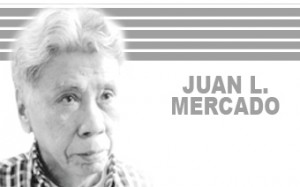 “Please tell me what this word means, Lolo,†our granddaughter Kathie once asked . She pointed to a headline in the papers and spelt out the word: “P-l-a-g-i-a-r-i-z-e.â€
“Please tell me what this word means, Lolo,†our granddaughter Kathie once asked . She pointed to a headline in the papers and spelt out the word: “P-l-a-g-i-a-r-i-z-e.â€
We took a deep breath and thought of the 1933 Cebuano carol titled “Kasadya Ning Takna-a.â€
Someone took “Kasadya Ning Takna-a†but titled it “Ang Pasko Ay Sumapit†in Filipino. They didn’t tell anybody.
“What is that?†we asked the two kids.“Stealing?â€, her elder sister Kristin asked.
“There. To plagiarize is to steal.â€
We’re now in the  midst  of the Advent season. We cross our fingers that, once again,    Manila Bulletin columnist Jullie Yap Daza   will do a rare public service since she, in 1978, hammered at the repeated farce.
“This country boasts of the longest celebration of Christmas,†Julie  wrote. “It remains supreme irony that not the slightest effort has been made to attribute the beloved carol ‘Ang Pasko Ay Sumapit’ to its author, Vicente D. Rubi†of Cebu.
Panorama Magazine recalls that, in 1933, Cebu Christmas festival officials asked composer Rubi to sign up for a carol or dayegon competition.
Rubi did and asked the then equally-young Mariano Vestil to scribble the lyrics for his music.
Their carol—“Kasadya Ning Takna-a†(How Joyous This Season Is)—won hands down. “Today, wherever Cebuano is spoken—Bohol, Negros Oriental, Southern Leyte, west part of Leyte, Northern Mindanao, Cebu and elsewhere—carolers still belt out the same infectious beat that Rubi and Vestil blended so brilliantly decades ago,â€
A Manila record company hijacked Rubi and Vestil’s carol for P150. Nong Inting, who died in 1980, “was denied what was due him in royalties,†Daza wrote. The platter firm conned Rubi and Vestil with legal dodges until their deaths.
It’s par for the course in a country where an “elite of thieves†govern. And those who crassly exploited Rubi and Vestil find kindred spirits in thieving opportunists—from those who splurge on the onerous levy of coconut farmers to loggers who trigger today’s flash floods, to plagiarists.
“Nong Inting†Rubi became an impoverished widower. Until his death in 1980, he’d shuffle to his gates and teach startled carolers how to sing his dayegon.
And in 2004, lyricist Vestil went to his grave, bereft of benefits other than an inside-page-below-the-fold newspaper obituary.
In Charles Dickens’ 1843 classic “A Christmas Carol,†the miser Ebenezer Scrooge dismissed as “humbug†what Vestil and Rubi celebrated as Christmas, which is not about tinsel, red-nosed reindeer, even shattered diets.
“We must be quiet and not fear the night, (or) else we will hear nothing,†the Jesuit theologian Karl Rahner wrote. “For the ultimate message is uttered only in the night’s stillness ever since, through the gracious arrival of the Word into the night of our life, Christmas’ silent night, holy night came down among us. The meaning of Christmas is that the emptiness of death is filled with the ‘nameless incomprehensibility of God.’â€
Advent 2015  finds star lanterns, Nativity belens and Christmas trees lit up. The “tambourine brigade†is out in full force. Scrawny school dropouts bang flattened bottle caps tacked to sticks, to accompany off-key carols.
A few are the Badjao from Mindanao, who scrape for a living from city streets.They sing—well, sort of—at doorways. Some do on rickety jeepneys they scamper into.
Their repertoire is limited. Some belt a few bars from “Silent Night,†or “Kasadya†aka “Ang Pasko.†Their unvarying finale is: “We Wish You a Merry Christmas.†They stretch open palms for handouts. If you drop an extra coin, they’ll chime: “Thank you/ Thank You/ Ang babait ninyo.â€
Poor nutrition stunts almost half of kids. They’re dwarfed by better-fed kids in Beijing, Seoul or Hong Kong. Many of them are frailer, and lag academically behind their Korean or Singaporean counterparts.
“The Bethlehem story, in Luke’s Gospel, gives us an ‘array of luminous images,’†the theologian Catalino Arevalo, SJ, writes in “They Shall Call Him
Emmanuel.â€
(We see) “the night sky alight with bright angels, simple shepherds, startled from sleep, mag. It is a happening, above all, for the deepest heart.
“Christmas is not, first of all, a revelation for the intelligence. It is looking at a Son who was born for us, who would die for us, because we mattered to Him, because we are infinitely cherished, infinitely loved. At the crib, the first task is to look, and looking to adore. ‘Venite adoremus.’ (By Juan L Mercado)
